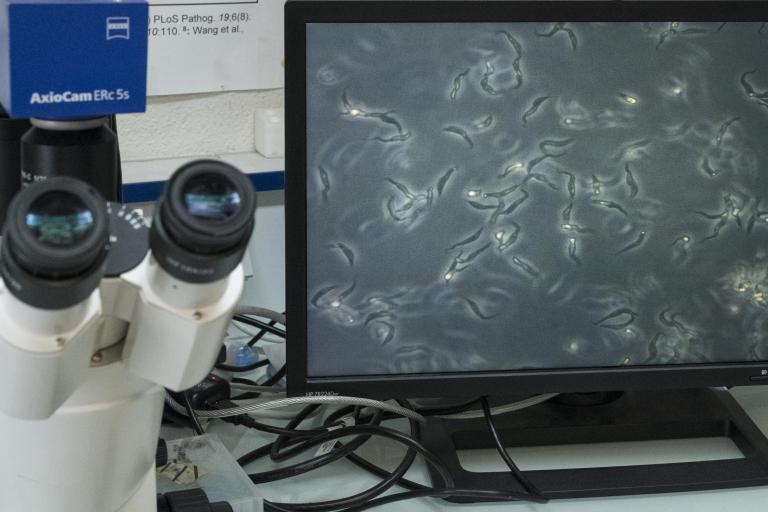PPL Parasites and Free-living Protists

© MNHN - Coralie Martin

© MNHN - Coralie Martin
The PPL teams focusses at understanding of the processes of adaptation of protists to their environment.
Our research is aimed at understanding of the processes of adaptation at the molecular and cellular level of the parasites and their environments from varied experimental models using species adapted to the laboratory (Plasmodium, Trypanosomes, Giardia, Filaria), as well as species isolated from wildlife or the environment (Haemosporidia, Gregarina). More recently, our team included models of free living protistes (ciliates, foraminifera), to be able to take into account this other neglected element of the biodiversity in questionings related to the inventory of the (micro)biodiversity and the role of microorganisms in ecosystems.

A few of the organisms studied in the team (A. Litomosoides, B. Trypanosoma, C. Haemosporidia, D. Plasmodium, E. Gregarina, F. Parastrongilidium)
The research themes of the team PPL articulate around two axes:
1) the description of the biodiversity and the evolution of these microorganisms
2) the functional analysis of the host-parasite interactions

Life cycles of the two main models
International collaborations

Collaborations of the team (publications, visitors and bilateral and international projects).
The size of of the circle is relative to the number of collaborations.
Financing
Muséum National D’Histoire Naturelle, CNRS – INEE, LABEX BcDIV, Industrial financing, European Programs, ANRs, Foundations, Regional financing
Collections associated with the team
The PPL team is in charge of two collections:
1. The protist collection of the Museum (for more information, see here )
2. The zooparasitic nematode collection of the Museum (for more information, see here )
Team leader | ||
|---|---|---|
Lecturer, MNHN | 01 40 79 35 03 | |
Composition | ||
Technician, MNHN | 01 40 79 35 02 | |
| BONRAISIN Véronique-Gail | Under contract | 01 40 79 35 16 |
Research engineer, MNHN | 01 40 79 35 16 | |
| COMTE Katia | Lecturer, MNHN | 01 40 79 37 30 |
| DEBAERE Sophie | Librarian | 01 40 79 35 98 |
| DELLINGER Marc | Lecturer, MNHN | 01 40 79 37 30 |
| DEPOIX Delphine | Lecturer, MNHN | 01 40 79 35 11 |
| DEREGNAUCOURT Christiane | Attachée | 01 40 79 35 04 |
| DUVAL Linda | Lecturer, MNHN | 01 40 79 35 09 |
| FLORENT Isabelle | Professor, MNHN | 01 40 79 35 47 |
| GEY Delphine | Technician, MNHN | 01 40 79 35 16 |
| GRELLIER Philippe | Professor, MNHN | 01 40 79 35 10 |
Lecturer, MNHN | 01 40 79 35 03 | |
Professor emeritus, MNHN | 01 40 79 35 00 | |
| MARTIN Coralie | Professor, MNHN | 01 40 79 34 96 |
Assistant engineer, CNRS | 01 40 79 35 16 | |
Technical assistant, MNHN | 01 40 79 35 14 | |
Attaché |
| |
Doctorants et post-doctorants | ||
| CORMERAIS Clément | PhD student | 01 40 79 35 03 |
| FERCOQ Frédéric | Post-Doctoral Researcher | 01 40 79 34 97 |
| LHERMITTE-VALLARINO Nathaly | Post-Doctoral Researcher | 01 40 79 34 97 |

Equipe PPL © MNHN

Trypanosoma brucei (procyclic form) © MNHN - Agnès Iatzoura

Analysis of a mouse lung section by microscopy © MNHN - Agnès Iatzoura

Microtome sectioning of tissu © MNHN - Agnès Iatzoura

Collection of Protists © MNHN - Agnès Iatzoura

Giardia duodenalis, Trophozoïte. Scanning electron microscopy © MNHN - Soraya Chaouch, Thibault Allain, Isabelle Florent